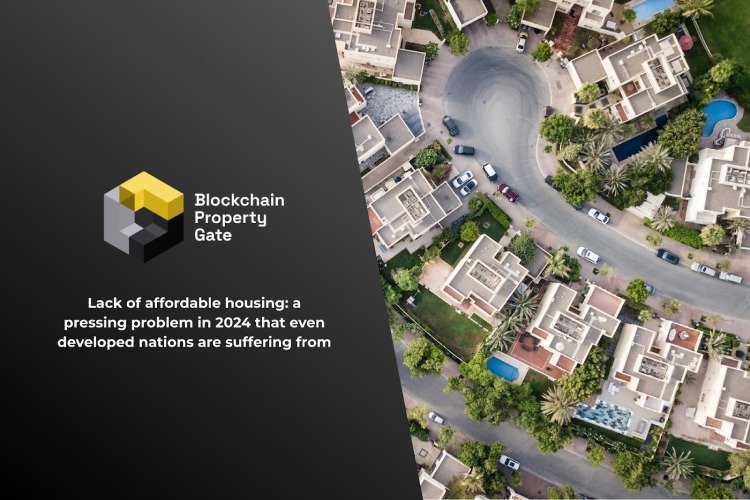Lack of Affordable Housing: a Problem in 2024 that Even Developed Nations are Suffering from

What does affordable housing mean exactly and why does it matter
The definition of affordable housing depends on the housing affordability index for the selected country, compared to the median household income in the same country. Basically, if people at or below the median can afford a home, the baseline real estate and rent prices can be considered affordable. This can be measured in monetary values — more specifically, by comparing the average rent price with the officially estimated value that is considered affordable and deducing whether it is equal or lower.
Naturally, this monetary value differs greatly from country to country due to differences in income and other factors, as well as from one location to another. In some countries with higher concentration of the population in big cities, the regional differences can be quite substantial — prices of rents and properties in big cities can be 5 times higher than those in distant rural areas on average, or even more.
A common disbelief is that developed countries are the ones suffering the least from the issue of lack of affordable housing. Indeed, the median income there is much higher than in developing countries, which means that less people live at or below the poverty line. However, this does not mean that the same goes about their housing situation. In fact, in some cases, it is the exact opposite — if we take Germany as an example, we observe less than 47% homeownership rate, which is among the lowest in all European countries. What is more, the affordable price for rent per square meter is estimated to be about 10,50 EUR, but the current average is considerably higher than that — 15 EUR per square meter.
How can the biggest issue in real estate be solved
The various intricacies and complexities of the problem with affordable housing make it very challenging, requiring a diversified approach. Additionally, every country has its own specific clusters of problems that might require a different way of going about solving the problem. At the same time, affordable housing is considered a basic human right according to the World Health Organization. Thus, seeking resolution should be at the forefront of governments’ efforts.
One way is through innovative approaches in legislation and urban planning that can lead to higher flexibility and efficiency — and we do not mean price ceilings on properties, rent prices or government subsidiaries. While these can provide some short-term alleviation of the issue, they do nothing to solve the problem in the long-term and could even end up being harmful for the economy and the real estate market itself. The key here is improving the way existing land and real estate projects are utilized, as well as easing the administrative procedures and legislation surrounding the construction and approval of new housing projects. In Germany for example, there is a large amount of old construction buildings that can be renovated and extended in order to fill in the shortage of housing units that is already significant — the country is currently providing less than 50% of the necessary new housing units per year.
Another way is through innovation in terms of financing options — currently, the whole sector is heavily dependent on banks due to the high prices. With rising interest rates, it could become increasingly difficult for borrowers to pay these loans back. This might be dangerous, as mass illiquidity of loan takers would undermine banks, which might result in another financial crisis like the one 15 years ago.
Blockchain technology is one potential solution that is especially applicable when it comes to both financing and investing. It offers an easy way of fractionalization through tokenization of properties, allowing multiple people to co-own a single property. The shares are kept on the blockchain and are secure due to the inherent transparency offered by distributed ledgers.
While there have already been some projects in the space that capitalize on the concept of blockchain for real estate, one new company with over 20 years of experience in the market is taking an innovative approach specifically designed to tackle the problem with lack of affordable housing and high capital requirements for real estate investors.
Blockchain Property Gate: a new approach
Blockchain Property Gate creates an ecosystem for the real estate sector that relies on a circular economy consisting of selection of undervalued properties at below market prices, their acquisition and renovation. The properties are then rented out or resold and the process is initiated again. The team behind the project has developed a strict methodology in every step along the way that is aimed at reaching an overall cost reduction per property of at least 25%. Through these cost efficiencies, Blockchain Property Gate envisions itself as a catalyst of the necessary change in making affordable housing a reality, while providing real estate investors with an easy and low-risk way of getting into the historically most profitable investment sector.
At the heart of the project is the BPGT security token, which is essentially supported by real estate assets and yields passive income in the form of sharing rights amounting to 30% of the net profit of Blockchain Property Gate. The token is audited and registered in the US, ensuring high security for investors.
The Blockchain Property Gate project is preparing for a private sale round in the beginning of 2024. If you want to learn more about the project, visit the website and considering reading the white paper for the most in-depth look into the plans of the project to revolutionize the real estate sector: https://blockchain-property-gate.com/